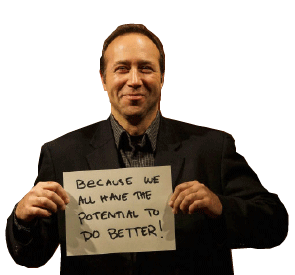A Culture of Care Begins With YOU!
When I first began writing this post I was targeting leadership, but then I realized many people with titles of leadership have adopted belief filters that will render this message inert. They’ll never see it and if they did, many will think their circumstances so unique the message doesn’t apply to them. But, you are smarter than this, so read on.
 This week, 3 noteworthy things happened:
This week, 3 noteworthy things happened:
- The CEO of Volkswagen resigned amid the discovery of emission cheating vehicle software and the subsequent battering of the company stock
- Turing Pharmaceuticals bowed to public pressure and agreed to reverse an abrupt 5000 percent price hike of the life saving drug Daraprim
- The former owner of the now defunct Peanut Corporation of America was sentenced to 28 years in prison for his role in a salmonella outbreak that killed 9 people and sickened hundreds
Pope Francis addresses the U.S. Congress
Amid these negative developments Pope Francis addressed members of the U.S. Congress.
I want to focus on a few words that Pope Francis shared, namely “culture of care”. Here they are in context.
“In Laudato Si’, I call for a courageous and responsible effort to “redirect our steps” (ibid., 61), and to avert the most serious effects of the environmental deterioration caused by human activity. I am convinced that we can make a difference and I have no doubt that the United States – and this Congress – have an important role to play. Now is the time for courageous actions and strategies, aimed at implementing a “culture of care” (ibid., 231) and “an integrated approach to combating poverty, restoring dignity to the excluded, and at the same time protecting nature” (ibid., 139). “We have the freedom needed to limit and direct technology” (ibid., 112); “to devise intelligent ways of… developing and limiting our power” (ibid., 78); and to put technology “at the service of another type of progress, one which is healthier, more human, more social, more integral” (ibid., 112). In this regard, I am confident that America’s outstanding academic and research institutions can make a vital contribution in the years ahead.”
Think about the possibilities for those words, “A Culture of Care”.
 Reasonable Investor Test
Reasonable Investor Test
I want to share a personal story. In 1998, I started a software company. As the founding CEO, it didn’t take long to realize I had two jobs, raising capital and building the organization’s operations. We hired an outside CEO to help and I took the reigns as the Chief Operating Officer. As the company grew I couldn’t be party to every decision, nor could I attend every meeting, though employees continued to seek my approval. I invented a test they could employ on their own, without me in the room. I called it the Reasonable Investor Test.
I explained it to them like this. Imagine yourself presenting your decision to a collection of 16 reasonable investors that politely assembled to hear your story.They are sitting across from you at a large table looking you directly in the eye. You are about to explain to them the decision you plan to make or the action you will take. If you can look them in the eye and justify the decision or expenditure, then it passes the test. If you would not be willing to do this then you probably should not make the decision or take the action you are considering.
I concocted this test after our CEO and VP of Sales decided to prematurely celebrate a customer win by indulging in a lavish and expensive meal for themselves. I begrudgingly approved the expense, but I didn’t think reasonable investors would have appreciated their invested money being spent this way. We never did win that customer and the CEO and VP of Sales never understood or embraced the Reasonable Investor Test. But, again you’re smarter than this, so read on.
Life beyond the spreadsheet or whim
A culture of care, like life, is a bit more complicated than what might initially appear favorable on a spreadsheet or what one might feel like doing at the moment. I’m guessing the former CEO of the Peanut Butter Corporation might today consider more stakeholders. I’m also guessing that the former CEO of Volkswagen might employ some sort of Reasonable Stakeholder Test for employees to use in guiding their own work or that of colleagues. Investors are not the only stakeholders just like spreadsheets are not the only tool. There are many other stakeholders to be considered, customers, employees, the environment. And closer to home, stakeholders might include neighbors, the community and even members of your household.
 Freed from the shackles of inaction
Freed from the shackles of inaction
Pope Francis shared great words with Congress. I hope members not only listened, but that they heard him. Imagine if Congress freed themselves of their own proverbial mental shackles and focused forward, to a new era, a “people-first” era that confronts reality, embraces science, respects natural resources, and advances prosperity for all households, even the people who don’t currently have one. Imagine possibilities where members act cooperatively, embracing a culture of care, leading the way the for the nation.
 But, even if they don’t, a culture of care can begin with each of us. At home, in school, in our communities, at work, even in the online community. So what about you? How will you create a culture of care, in your home, in your work, in your community? You’ll likely need a test to go with it. What will be your equivalent Reasonable Investor Test? We really can all do better as individuals, organizations, and the world community. I hope you’ll do your part. Onward.
But, even if they don’t, a culture of care can begin with each of us. At home, in school, in our communities, at work, even in the online community. So what about you? How will you create a culture of care, in your home, in your work, in your community? You’ll likely need a test to go with it. What will be your equivalent Reasonable Investor Test? We really can all do better as individuals, organizations, and the world community. I hope you’ll do your part. Onward.
about the author
 Gregory Olson is a consultant, speaker, and author. His latest book is L’ impossi preneurs: A Hopeful Journey Through Tomorrow.
Gregory Olson is a consultant, speaker, and author. His latest book is L’ impossi preneurs: A Hopeful Journey Through Tomorrow.
Greg also authored, The Experience Design Blueprint, a book about designing better experiences and then making them come true. The models in the Experience Design BLUEPRINT are equally relevant to organizations of all types and sizes including start-up entrepreneurs, nonprofi ts, for-profi ts, and government.
See a book summary. Read the book reviews on Amazon. Read The Experience Design Blueprint on Kindle or any device using the free Kindle Reader application or read the full-color print edition.


 Robots Don’t Kill Jobs But CEOs Do
Robots Don’t Kill Jobs But CEOs Do More plainly, it is about greed. The intent is to move money that would otherwise be paid to workers and redistribute instead to leadership and investors, either directly or indirectly. It is a flawed equation from the onset. History is proving this more and more, if only we would learn. Unfortunately, maximizing shareholder value and its related bad ideas are still perpetuated by business schools, investors of the short run, and the unwitting. There are simply more stakeholders to the equation that are made to be invisible, namely humans and the environment. Smart progressive leaders and companies already realize this. So do the customers that align to those values.
More plainly, it is about greed. The intent is to move money that would otherwise be paid to workers and redistribute instead to leadership and investors, either directly or indirectly. It is a flawed equation from the onset. History is proving this more and more, if only we would learn. Unfortunately, maximizing shareholder value and its related bad ideas are still perpetuated by business schools, investors of the short run, and the unwitting. There are simply more stakeholders to the equation that are made to be invisible, namely humans and the environment. Smart progressive leaders and companies already realize this. So do the customers that align to those values. A better world begins with the decisions made at dinner tables and carried through to the office and the board room. CEO decisions don’t live in some special vacuum. When a Hungarian camerawoman decides to trip a man carrying his child as they strive for refuge and a fresh start, the world watches. And, when a CEO chooses to trip a person or family that relied on a paycheck, also on the way to somewhere, the world watches, too. The song of cuts has been played over and over again. In the case of HP, 100,000 jobs cut in the last 10 years. In the case of Microsoft 20,000+ in recent years. For HSBC is was 50,000 jobs recently announced to be cut and Deutsche Bank yesterday announced it will cut 25% of its workforce, or 23,000 human beings. Plenty of other examples abound. It is time to change the music. It’s also time to own up to the decision and stop blaming “things”.
A better world begins with the decisions made at dinner tables and carried through to the office and the board room. CEO decisions don’t live in some special vacuum. When a Hungarian camerawoman decides to trip a man carrying his child as they strive for refuge and a fresh start, the world watches. And, when a CEO chooses to trip a person or family that relied on a paycheck, also on the way to somewhere, the world watches, too. The song of cuts has been played over and over again. In the case of HP, 100,000 jobs cut in the last 10 years. In the case of Microsoft 20,000+ in recent years. For HSBC is was 50,000 jobs recently announced to be cut and Deutsche Bank yesterday announced it will cut 25% of its workforce, or 23,000 human beings. Plenty of other examples abound. It is time to change the music. It’s also time to own up to the decision and stop blaming “things”.

 Human progress is overdue. It’s time we return the keys to the makers. Let’s once again make, create, invest. Let’s celebrate progress, collaborate, innovate. Let’s inspire. Let’s be authentic. Let’s be concerned. Let’s invite newcomers to the table. Let’s keep our promises both explicit and implicit. Let’s solve problems of the world. Boards need to support CEO actions in this regard and then hold them to account.
Human progress is overdue. It’s time we return the keys to the makers. Let’s once again make, create, invest. Let’s celebrate progress, collaborate, innovate. Let’s inspire. Let’s be authentic. Let’s be concerned. Let’s invite newcomers to the table. Let’s keep our promises both explicit and implicit. Let’s solve problems of the world. Boards need to support CEO actions in this regard and then hold them to account.





 Keep Synchronized
Keep Synchronized Don’t Ignore Conditions
Don’t Ignore Conditions Be Mindful of the Audience
Be Mindful of the Audience



 It turns out this brain behavior is self preserving. Imagine that we didn’t complete patterns and we had to slow down and think about every single l e t t e r that we typed or r e a d. Imagine that we had to re-learn how to walk each day and to tie our shoes and even how to put those shoes on. Or, that we had to consult our mental checklist for everything we came across to assess its potential threat. Of course everyday life would become daunting with the sheer volume of things we encounter and decisions we face as we go about living, working, and recreating.
It turns out this brain behavior is self preserving. Imagine that we didn’t complete patterns and we had to slow down and think about every single l e t t e r that we typed or r e a d. Imagine that we had to re-learn how to walk each day and to tie our shoes and even how to put those shoes on. Or, that we had to consult our mental checklist for everything we came across to assess its potential threat. Of course everyday life would become daunting with the sheer volume of things we encounter and decisions we face as we go about living, working, and recreating. Think of how long it takes you to accept the new. Think of your struggle with and opposition to new ideas and initiatives. This same pattern making behavior your brain habitually engages in every day is also the reason why you drink the same coffee, listen to the same radio station, visit the same stores, wear the same brand shoes, and everything else that forms your consumer habits.
Think of how long it takes you to accept the new. Think of your struggle with and opposition to new ideas and initiatives. This same pattern making behavior your brain habitually engages in every day is also the reason why you drink the same coffee, listen to the same radio station, visit the same stores, wear the same brand shoes, and everything else that forms your consumer habits.










 Gregory Olson founded strategy and design firm Delightability, LLC. with the belief that if you delight customers then success will follow. He believes that we all have the potential to do better, as individuals, organizations, and communities, but sometimes we need a little help. Gregory also serves as a volunteer board member for
Gregory Olson founded strategy and design firm Delightability, LLC. with the belief that if you delight customers then success will follow. He believes that we all have the potential to do better, as individuals, organizations, and communities, but sometimes we need a little help. Gregory also serves as a volunteer board member for 
